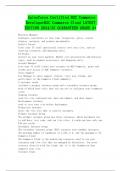Exam (elaborations)
Salesforce Certified B2C Commerce DeveloperB2C Commerce Cloud LATEST EDITION 2024/25 GUARANTEED GRADE A+
- Course
- Institution
Business Manager Configure storefronts in real time. Categorize, price, search, display, navigate, and promote merchandise. Control Center Gives your IT staff operational control over your site, such as starting instances, and managing users. UX Studio Install on your local machine. Modify sit...
[Show more]



